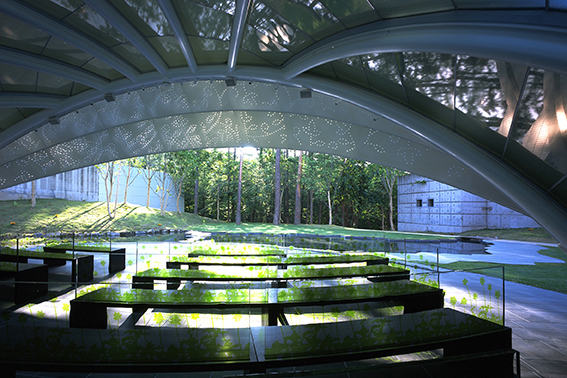Fe y romance
La arquitectura de las Iglesias cristianas en Japón y el tema de las capillas nupciales
DOI:
https://doi.org/10.17979/aarc.2022.9.0.9348Palabras clave:
Japón, iglesia, capillas nupciales, tipología edificatoria, apropiación culturalResumen
Durante mucho tiempo, los edificios eclesiásticos japoneses apenas tuvieron interés para los observadores occidentales. Esto cambió a partir de finales de la década de 1980, cuando la Capilla sobre el Agua de Tadao Andô captó su atención, al igual que los edificios de Jun Itami y Fumihiko Maki. Las obras de estos arquitectos alimentaron la búsqueda global de un diseño contemporáneo del culto. Sin embargo, generaron un problema discursivo: casi ninguno de estos intrigantes edificios es realmente una iglesia, o un lugar de culto en un sentido más general. Se trata, en gran medida, de espacios para escenificar y celebrar una relación romántica. El trasfondo empresarial no cambia la expresividad y la calidad de la arquitectura, pero sí el contexto económico y funcional en el que se crea y mantiene un edificio. Además, plantea preguntas sobre el modo en que las ideas de religión y arquitectura recorren el mundo y conllevan un significado, tanto universal como local.
Descargas
Métricas
Citas
Aali, Heta, Anna-Leena Perämäki y Cathleen Sarti, eds. 2014. Memory Boxes. An Experimental Approach to Cultural Transfer in History, 1500-2000. Bielefeld: Transkript.
Agri. 2017. «Agri Chapel / Yu Momoeda Architecture Office», ArchDaily, 5 de mayo. Consultado el 09/05/2022, https://bit.ly/3E0GnzK
Ballhatchet, Helen J. 2003. «The Modern Missionary Movement in Japan. Roman Catholic, Protestant, Orthodox». En Handbook of Christianity in Japan, editado por Mark R. Mullins, 35-68. Leiden/Boston: Brill.
Bellclassic. 2022. «Wedding Halls», The Bellclassic Group. Homepage. Consultado el 09/05/2022, https://www.bellclassic.co.jp/hall/
Birch. 2022. «Birch Moss Chapel», Kengo Kuma and Associates. Homepage. Consultado el 09/05/2022, https://bit.ly/3RbxetN
Borngässer, Barbara y Bruno Klein, eds. 2022. Global Gothic. Gothic Church Buildings in the 20th and 21st Centuries. Leuven: Leuven University Press.
Brasor, Philip. 2011. «Mr. Momoe Yamaguchi Finally Decides to Speak». The Japan Times (online), 11 de diciembre. Consultado el 05/05/2022, https://bit.ly/3yGpJpf
Buruma, Ian. 1984. A Japanese Mirror. Heroes and Villains of Japanese Culture. London: Penguin.
Crosbie, Michael. J. 2017. «Defining the Sacred». Actas de Arquitectura Religiosa Contemporánea 5: 352-367. https://doi.org/10.17979/aarc.2017.5.0.5163
De Maeyer, Jan y Luc Verpoest, ed. 2000. Gothic Revival. Religion, Architecture and Style in Western Europe 1815–1914. Leuven: University Press Leuven.
Drazen, Patrick. 2017. Holy Anime! Japan's View of Christianity. Lanham: Hamilton Books.
Finn, Dallas. 1995. Meiji Revisited. The Sites of Victorian Japan. New York et al.: Weatherhill.
Germann, Georg. 1974. Neugotik. Geschichte ihrer Architekturtheorie. Stuttgart: Deutsche Verlagsanstalt.
Goldstein-Gidoni, Ofra. 1997. Packaged Japaneseness: Weddings, Business and Brides. Honolulu: University of Hawaii Press.
Gonçalves, Jose Fernando (2017). «Espacios sagrados: Significado, proyecto, construcción». Actas de Arquitectura Religiosa Contemporánea 5: 220-229. https://doi.org/10.17979/aarc.2017.5.0.5153
Hecken, Joseph Leonard van. 1963. The Catholic Church in Japan since 1859. Tokyo: Herder.
Hendry, Joy. 1981. Marriage in Changing Japan: Community and Society. London: Croom.
Hudson, Danny. 2016. «A look inside Kendrick Kellogg's Hoshino Stone Church in Japan», DesignBoom, 16 de abril. Consultado el 27/09/2022, https://bit.ly/3foeUjS
Jennes, Joseph. 1973. A History of the Catholic Church in Japan. From its Beginnings to the Early Meiji Era. Tokyo: Oriens Institut for Religious Research.
Kammerhofer-Aggermann, Ulrike, ed. 2000. "The sound of music" zwischen Mythos und Marketing. Salzburg: Salzburger Landesinstitut für Volkskunde.
Kano-cho. 2019. «Chûo-ku Kano-cho 2-chome no kinkyo [The recent situation of Kano-cho 2-chome in Chûo ward]». Entrada de blog, 4 de agosto. Consultado el 05/05/2022, https://bit.ly/3a2EmJ7
Kekkonshiki. 2022. Sutâ no kekkonshiki [Star’s wedding]. Consultado el 05/05/2022, https://bit.ly/3S9FFr5
King, Anthony. 2004. Spaces of Global Cultures. Architecture, Urbanism, Identity. London: Routledge.
Leaf. 2004. «Leaf Chapel». Klein Dytham architecture. Homepage. Consultado el 10/05/2022, https://bit.ly/3r2G8PK
LeFebvre, Jesse. 2015. «Christian Wedding Ceremonies, ‘Nonreligiousness’ in Contemporary Japan». Japanese Journal of Religious Studies 42/2: 185–203.
Löffler, Beate. 2011. Fremd und Eigen: Christlicher Sakralbau in Japan nach 1853. Berlin: Frank und Timme.
Löffler, Beate. 2018. «Acculturated Otherness. Christian Churches and Wedding Chapels in Modern Japanese Society». Entangled Religions 5: 312-346.
Löffler, Beate. 2021. «Catholic Church Architecture in Japan, 1923-2020: Negotiating Technology and Meaning of Form». En The Palgrave Handbook of the Catholic Church in East Asia: China, Korea, and Japan, editado por Cindy Yik-yi Chu y Betrice Leung, sp. Singapore: Springer Nature. https://doi.org/10.1007/978-981-15-9365-9_42-1
Löffler, Beate. 2022. «Catholic Church Architecture in Japan, 1542-1923: Searching for Space and Form». En The Palgrave Handbook of the Catholic Church in East Asia: China, Korea, and Japan, editado por Cindy Yik-yi Chu y Betrice Leung (in print).
Luster. 2019. «Cloud of Luster Chapel / KTX archiLAB». ArchDaily, 24 de abril. Consultado el 09/05/2022, https://bit.ly/3Mnoork
Meijimura. 2022. «Daimyoji Sei Paoro Kyoukaido [St. Paul Daimyoji Church]», Meijimura Architectural Museum. Consultado el 10/05/2022, https://bit.ly/3NdCeN4
Miyazaki, Kentaro. 2003. «Roman Catholic Mission in Pre-Modern Japan». En Handbook of Christianity in Japan, editado por Mark R. Mullins, 1-18. Leiden/Boston: Brill.
Mullins, Mark R., ed. 2003. Handbook of Christianity in Japan. Leiden/Boston: Brill.
Naito, Yuko. 2001. «The Big Day. Modern Couples Seek to Tweak the Nuptial Norms». The Japan Times online, 5 de agosto. Consultado el 05/05/2022, https://bit.ly/3sJDuQ3
Nanbandera. 2022. «Miyakononanbandera [The Nanban Temple in Kyoto, 1581–1587]». Kobe City Museum. Consultado el 05/05/2022, https://bit.ly/3Lsh4JA
Nidom. 2022. «Chapel of Stone». The Nidom Resort. Consultado el 27/09/2022, https://bit.ly/3DWRfRT
Obayashi Taryo. 1997. «Der Ursprung der shintoistischen Hochzeit». En Rituale und ihre Urheber: Invented Traditions in der japanischen Religionsgeschichte, editado por Klaus Antoni, 39-38. Hamburg: Lit.
RAA. 2022. «Setre Chapel», Ryuichi Ashizawa Architect & associates. Consultado el 27/09/2022, https://bit.ly/3fqlVkx
Rainbow. 2015. «Rainbow Chapel / Kubo Tsushima Architects», ArchDaily, 5 de agosto. Consultado el 09/05/2022, https://bit.ly/3FYIzcP
Ribbon. 2015. «Ribbon Chapel / Hiroshi Nakamura & NAP». ArchDaily, 4 de febrero. Consultado el 13/09/2022, https://bit.ly/3xS58gy
Scheid, Bernhard. 2022. «Heirat». Religion in Japan. Consultado el 05/05/2022, https://bit.ly/3R8SU9Z
Shimada, Shingo. 2000. Die Erfindung Japans. Kulturelle Wechselwirkung und nationale Identitätskonstruktion. Frankfurt-am-Main/New York: Campus.
Smith, Robert J. 1995. «Wedding and Funeral Ritual. Analysing a Moving Target». En Ceremony and Ritual in Japan: Religious Practices in an Industrialized Society, editado por Jan van Bremen, 25-37. Londres: Routledge.
Sound. 2014. «Ecotone Hotel in Biwako - Sound Of Wind / Ryuichi Ashizawa Architects & associates». ArchDaily, 2 de febrero. Consultado el 13/09/2022, https://bit.ly/3LCWb0d
Stewart, David B. 2002. The Making of a Modern Japanese Architecture. From the Founders to Shinohara and Isozaki. Tokyo: Kodansha International.
















